Whether the shocks on your Tacoma have worn out over time and it’s time for a replacement, or if you’re looking to upgrade them for improved on-road and off-road drivability, you’ve come to the right place.
It doesn’t matter if your Tacoma is a 2wd daily driver or a 4wd weekend toy, installing aftermarket shocks is always a great idea if you want to improve its handling performance.
But there’s a lot that you need to consider before replacing the shocks on your Tacoma. In this article, we’ll help you make the right choice, and we’ll conclude by reviewing some of the best Tacoma shocks that you can buy.
Types of Suspension Upgrades for Light Trucks
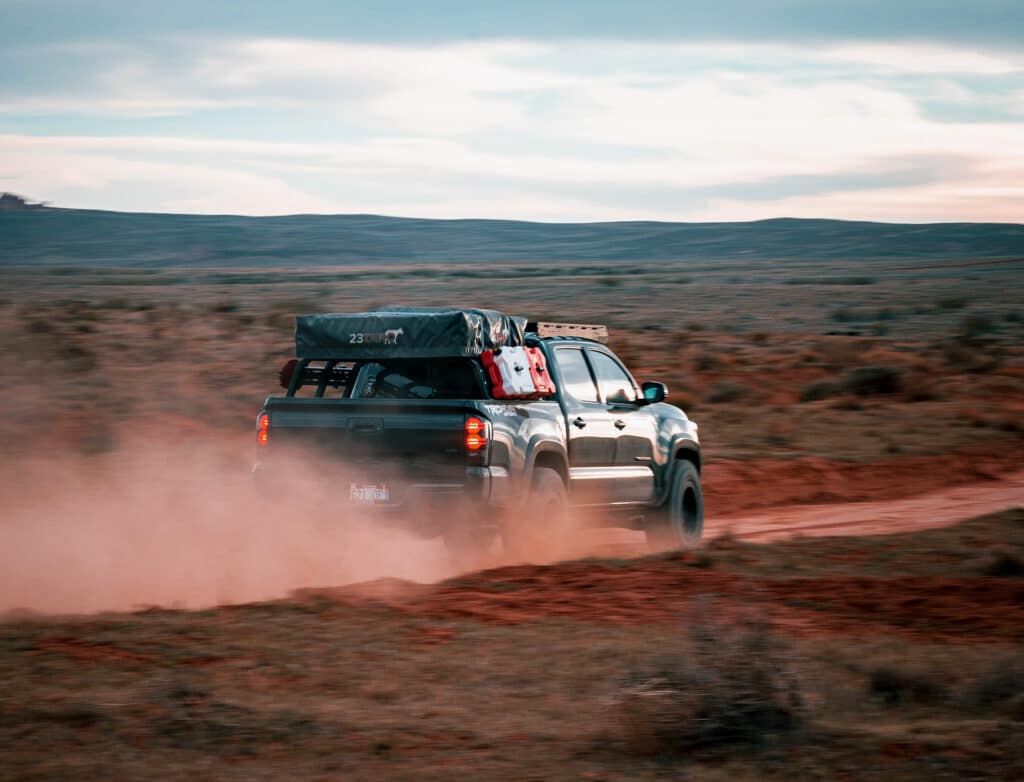
First things first — what does “shocks” even mean? Industry terminology varies significantly in the world of aftermarket suspension, and if you’re a newcomer, it can be confusing.
We’ve clarified some of the confusion around suspension nomenclature in our guide that explains the difference between coilovers and struts.
Here’s a quick comparison between light-truck-focused suspension upgrades like shocks, lift kits, and leveling kits.
Leveling Kits
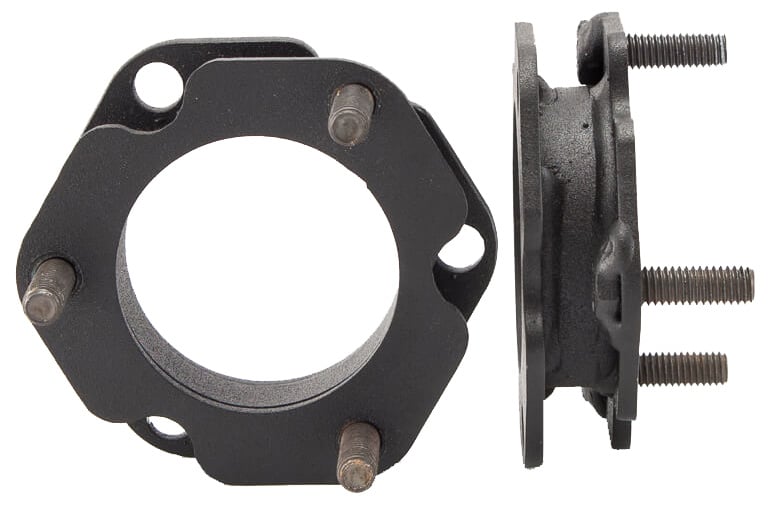
Tacoma leveling kits include a combination of components that add only body lift to increase ride height, correct driver-lean, improve the approach angle, and counteract the squat caused by having a loaded bed.
These include rear blocks, front spacers, shims, and add-a-leaf to increase the ride height by up to 3″.
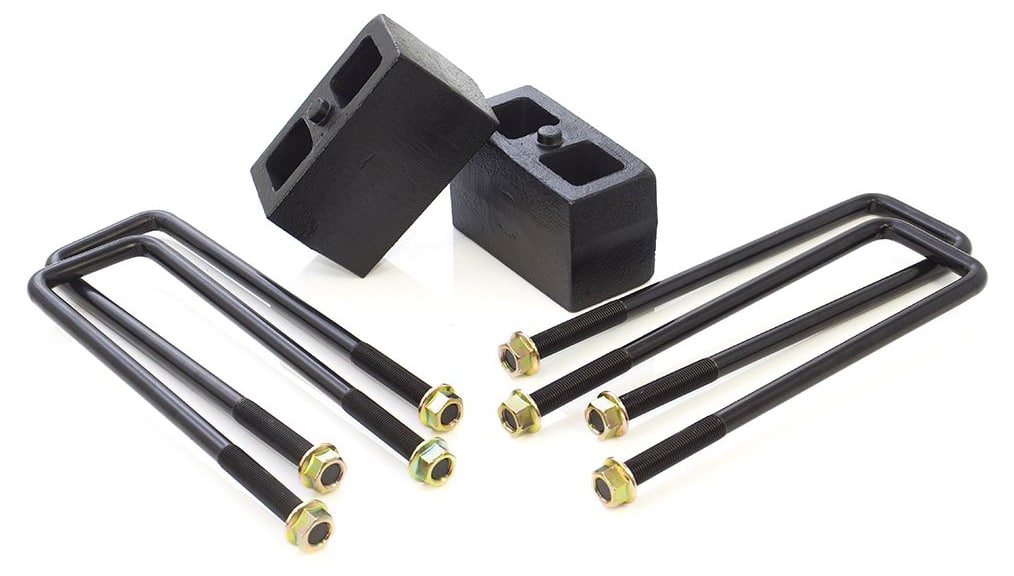
Installing a leveling kit will also allow you to marginally increase your Tacoma’s tire size. But if you want taller, higher aspect ratio tires, then you’re better off with a lift kit.
Shocks and Coilovers
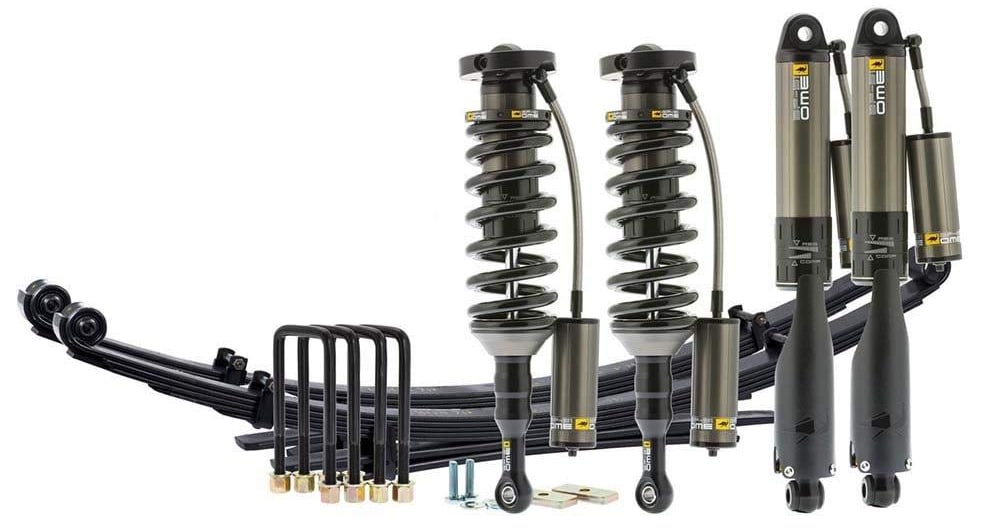
This category excludes any component that doesn’t affect suspension movement directly. It only includes parts such as coilovers, air shocks, bypass shocks, dampers like the Bilstein 5100, and/or leaf packs.
Components such as blocks, shims, and spacers are often seen as part of lift kits as well as leveling kits, but they’re not considered “shocks,” so to speak.
Lift Kits
Tacoma lift kits include an assortment of components that add body lift, as well as suspension lift for increased ground clearance and ride height by up to 7″.
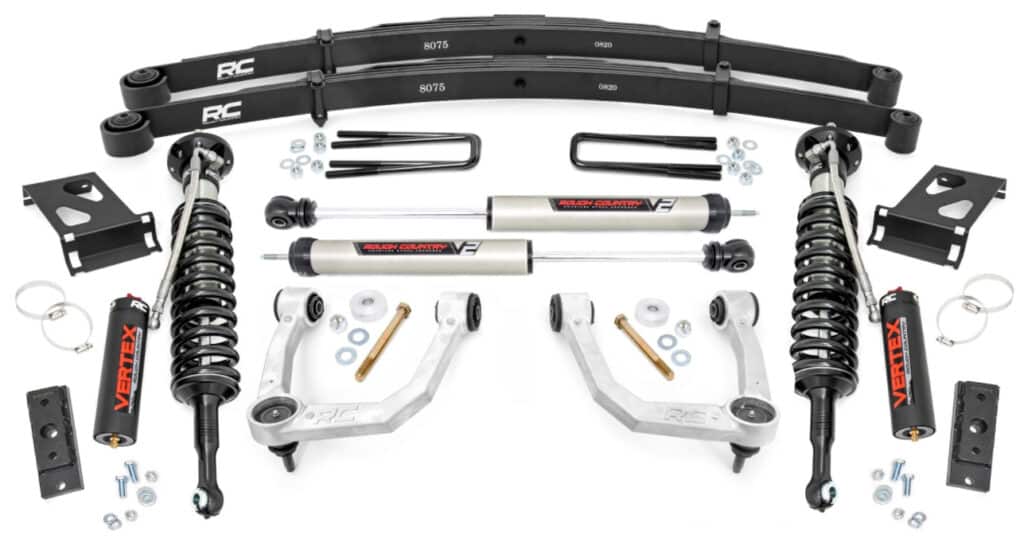
These components can be purchased either individually or in pre-packaged bundles. For instance, add-a-leaf, leaf packs, coilovers, shocks, spacers, blocks, shims, control arms, etc.
The main purpose of lift kits is to make room for significantly larger wheels and tires; and for better off-road performance.
It’s worth mentioning that your ground clearance can only be raised by installing larger tires and wheels for your Tacoma.
Replacing the Shocks on Your Tacoma
The main question to ask yourself when you’re in the market for new Tacoma shocks is whether you’re looking for a body lift or suspension lift. If you want the latter, then you’ll find something that works for you in this article.
If you want a mix of both, then you want a lift kit. And if you simply want to level your truck using parts that allow for a body lift, then you’re better off with a leveling kit instead.
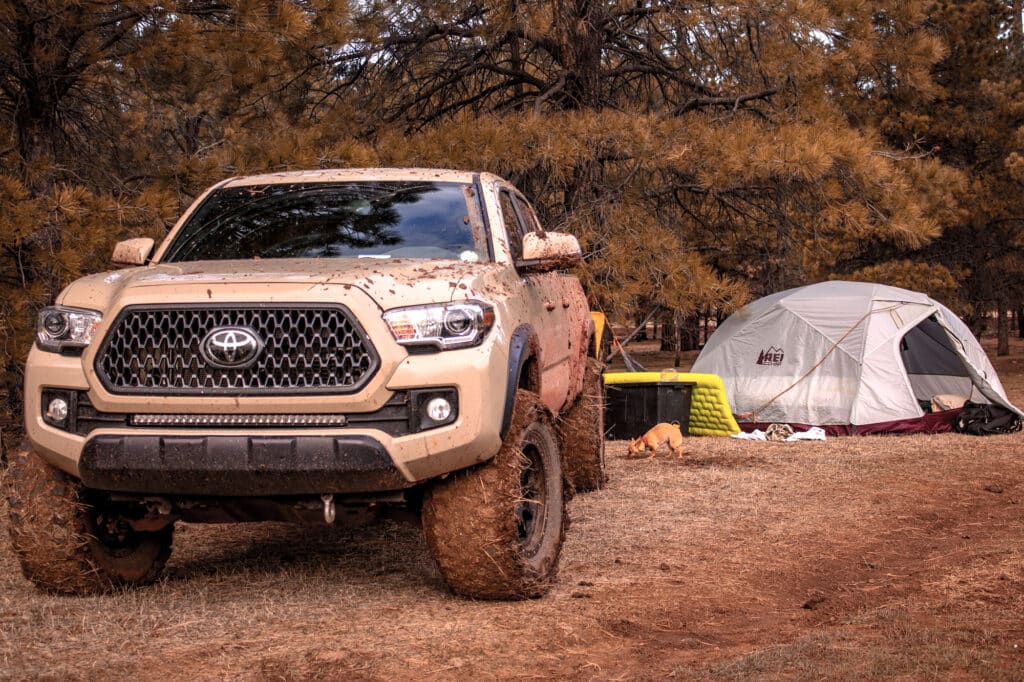
Because while a set of new shocks can really improve the ride quality of your Tacoma, if your goal is to simply lift or level your Tacoma, installing aftermarket coilovers might be overkill.
However, if you take off-road driving seriously and want to turn your Tacoma into an overlanding rig, then aftermarket shocks are your best bet.
Basic Suspension Tech and Types of Shocks
The stock suspension on your Tacoma is optimized from the factory for a blend of street and light off-road performance.
Upgrading it will allow you to do things like raise your ride height, fit larger tires, and dial in your setup in a way that suits your driving style.
However, the degree to which you can modulate your truck’s ability to tackle different kinds of terrain and difficulty levels depends entirely on the type of aftermarket suspension you choose.
Many Tacoma owners quickly outgrow their new shocks as a result of upskilling and wanting to traverse more and more difficult terrain. Others find themselves spending thousands on shocks that are never utilized to their full potential.
There’s a dizzying amount of engineering that goes into these suspension components, and the more of it you understand the better, because it will allow you to make an informed decision.
Below we’ve discussed the different types of shocks you’re going to come across, along with some of the technology associated with them. We’ll explore both extremes — what’s overkill, and what’s the bare minimum you need.
Nitrogen Charged Shocks
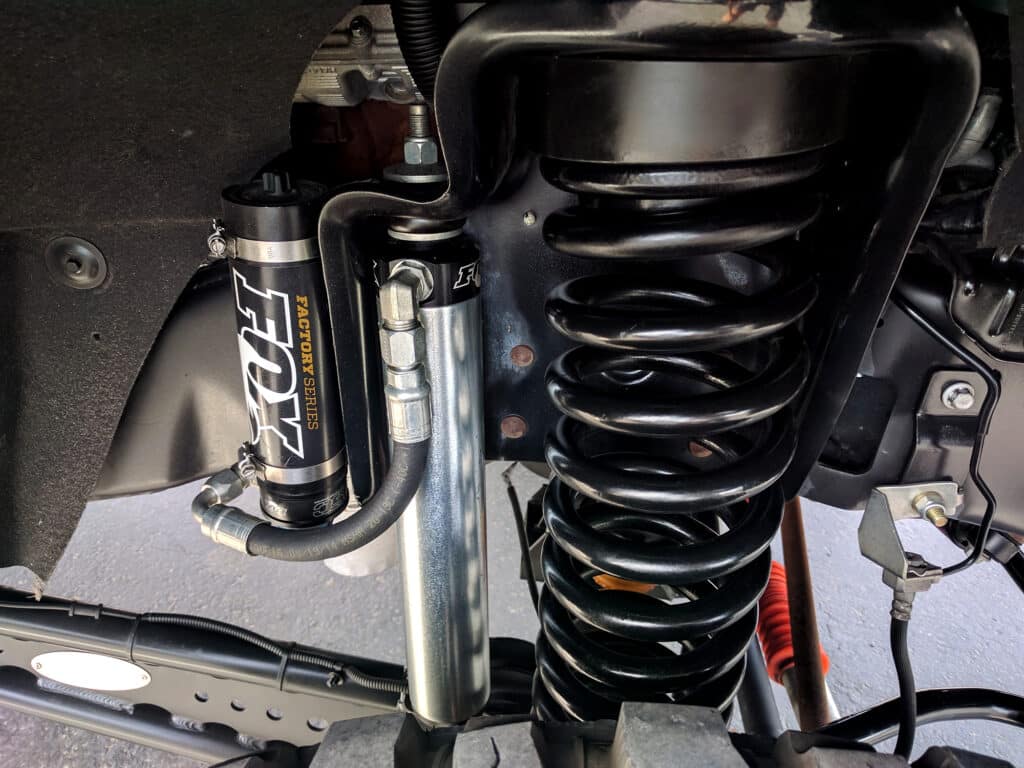
Hydraulic dampers have been used in automotive applications for nearly a century. The purpose of these devices is to slow down the compression and rebound rate of a spring. This is done by moving a restriction of some sort through an oil volume.
The restriction converts mechanical energy to heat energy which disperses into the oil contained within the shock body. Without dampers, cars would drive like pogo-sticks.
Before nitrogen-charged shocks became a thing, dampers were nothing but an oil-filled cylinder containing a piston rod connected to an orifice plate to restrict movement.
Advancements in the automotive world gave rise to countless different mechanisms to regulate the flow of oil within the shock in order to create the required damping action.
One of the advancements that really stuck was the use of nitrogen gas in conjunction with oil. Barring foam-cell dampers, pretty much all shocks utilize a combination of hydraulic fluid (oil) and nitrogen gas contained within a sealed chamber.
The two are separated with the help of either a floating piston, external chambers, bypass tubes, or a remote reservoir.
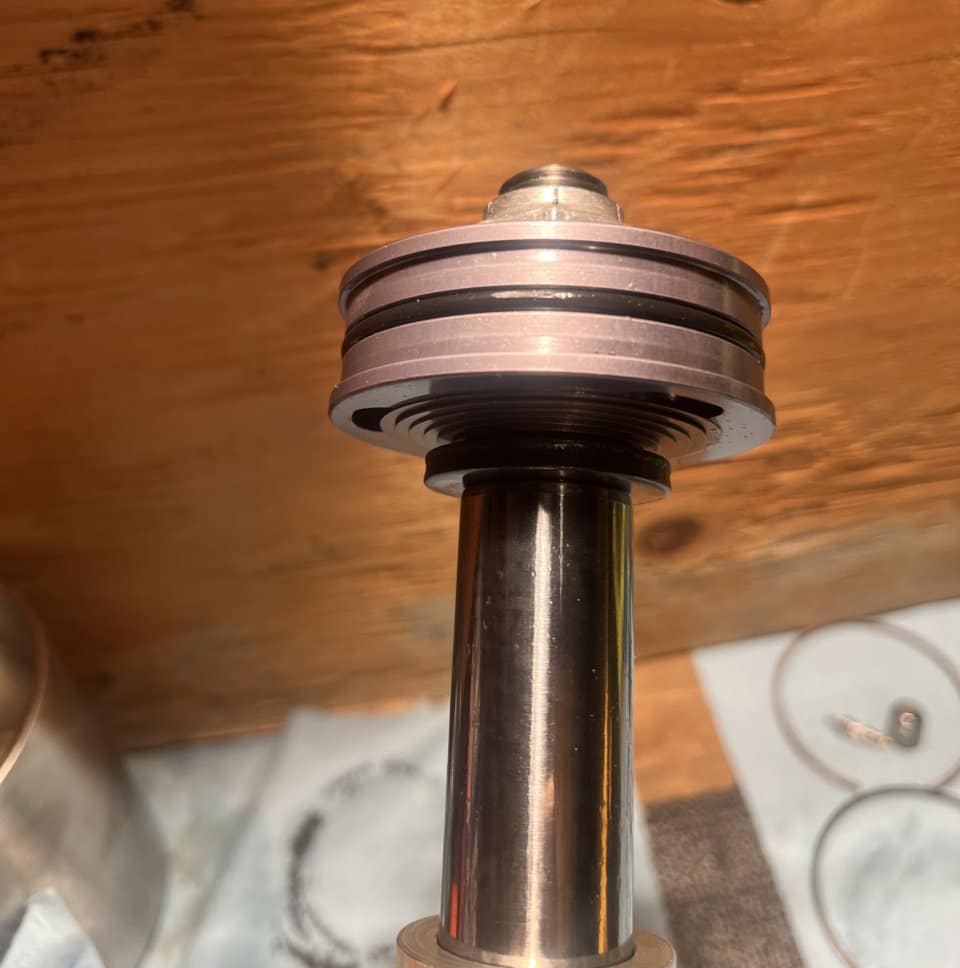
The reason why this combination works so well is that nitrogen gas is compressible, unlike hydraulic fluid. This allowed manufacturers to move away from traditional orifice plates to valved pistons.
Valved pistons can be rebuilt using countless different combinations of shim stacks, which opens up a plethora of different options to fine tune the flow of oil through the cylinder.
This translates to being able to change how the shock behaves by modulating the damping curve in a way that wasn’t possible before. Other factors that influence the damping curve include spring rate, nitrogen-charge pressure, and oil viscosity.
Monotube and Twin-Tube Shocks
When you’re shopping for shocks and/or coilovers for your Toyota Tacoma, there are two main types of dampers you’re going to come across: twin tube and monotube.
Twin-tube dampers have an inner chamber that houses the hydraulic fluid, and an outer chamber for nitrogen gas, which makes them multi-valved.
In monotube dampers, however, the hydraulic fluid and gas are contained in the same chamber, along with a free piston that separates the two.
Between the two, there’s really no doubt that monotube shocks have a clear edge when it comes to ease of installation and build quality.
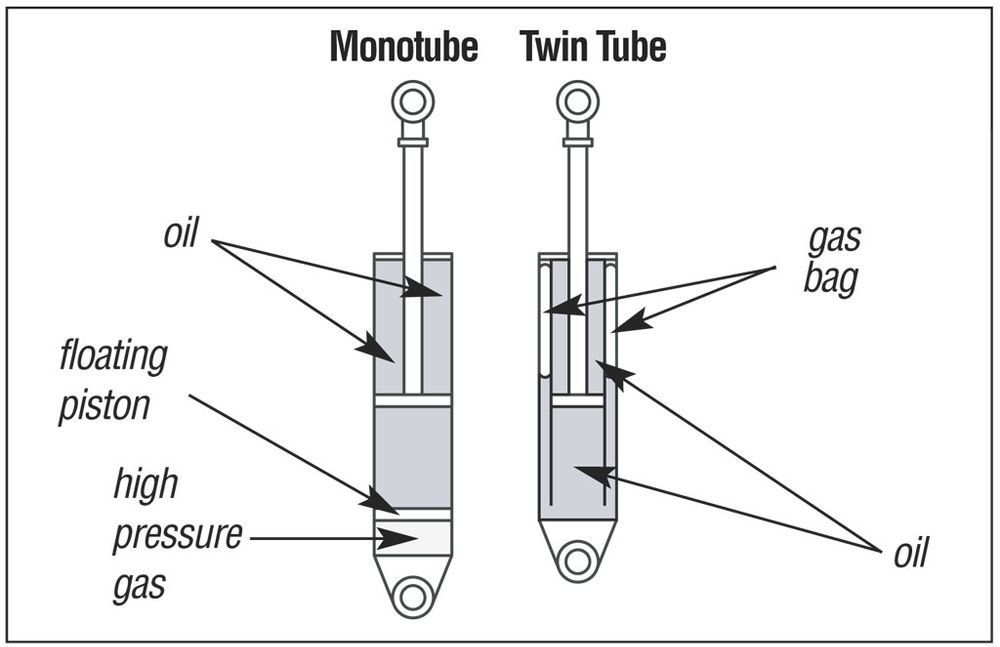
While monotube shocks are a lot more expensive, they do tend to last longer though and offer higher levels of adjustability.
So if you can’t decide between the two options, go with monotube shocks, but don’t feel like it’s the end of the world if you don’t want to fork out the extra cash and decide to go with twin-tube shocks.
Both twin tube and monotube shocks can be had in either steel or aluminum. Steel shocks are cheaper, but aluminum shocks are lighter and better at dissipating heat.
You’ll come across threaded and non-threaded options which rely on Circlips to hold the spring captive at the bottom end. Threaded shock bodies allow for ride height and preload adjustments.
These shocks are often sold as coilovers (with the coil spring wound over the shock body), but you can also buy just the shocks.
If you go for the latter, they’ll have to be outfitted with springs which you’ll have to purchase separately. Examples include the ever-popular Bilstein 5100 and Rough Country V2.
Emulsion Shocks
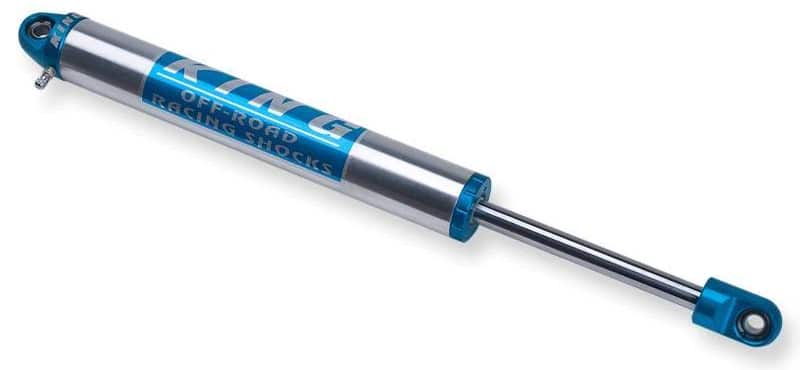
These contain an emulsified mixture of oil and nitrogen which is neither separated by a floating piston, nor routed into a separate reservoir of some sort.
Emulsion shocks work best with less aggressive piston movements at low suspension cycle speeds.
Under aggressive use and high load scenarios, these shocks cannot handle internal pressure effectively, as the oil tends to cavitate and foams up, reducing the damping ability.
If shock fade is a serious concern for your driving style, we recommend not installing emulsion shocks on your Tacoma.
Remote and Piggyback Reservoir Shocks
The main advantage of reservoir-equipped shocks is that the main piston gets to do all its traveling through oil and nothing else. It doesn’t have to deal with the obstruction caused by oil-gas seperators or separate chambers.

This is made possible because the nitrogen chamber is moved outside the shock body in the form of a remote or piggyback reservoir.
As a result, the piston has access to the entire length of the shock body, allowing for more travel. Extra oil definitely helps keep the overall shock system cooler.
The higher gas pressure helps to prevent cavitation. So effectively, you get more gas, more oil, less pressure on the seals, less heat fade, and a lower operating temperature.
Reservoir shocks are ideal for aggressive driving, and many will agree that they’re a bit overkill for daily driving.

The best part is that most of these shocks allow you to adjust the compression and rebound settings at the click of a knob. This will come in handy when you’re out on the trail, about to encounter various different types of terrain.
Internal and External Bypass Shocks
External bypass shocks aren’t usually sold with springs; you get just the shocks when you buy these, and so you’ll need some type of spring to suspend your truck.
Bypass shocks are the holy grail of aftermarket off-road suspension, and so they’re often seen on trophy trucks and race-ready off-road vehicles.
These feature a gas-charged piggyback reservoir and anywhere between 2 to 7 (or more) tubes on different zones on the outside of the shock body.
The purpose of these tubes is to allow the oil to temporarily pass into different zones outside the main shock body, making it possible for you to tune it in a way that it behaves differently at different points in the shock’s travel range.

Bypass tubes are highly tunable, in the sense that you can alter how much oil can or cannot flow into them with the simple twist of a knob.
For instance, the lowermost bypass tube is typically reserved for controlling rebound. By adjusting the dial specific to that tube, you’ll be able to control how freely the oil can move into that tube, which effectively allows you to control rebound sensitivity.
The whole idea of bypass shocks is to have different damping rates at different points in the shock’s range of travel.
It can be kept soft for the initial few inches of travel, but will get stiffer as the piston displaces more area in the shock body and travels further up.
This brings us to the concept of position sensitive damping vs velocity sensitive damping.
All shocks are velocity sensitive, in the sense that they provide greater resistance as the damping force and speed increases.
This is especially useful when the same truck requires softer damping on slow but technical trails, and stiffer damping at higher speeds, when traversing washboards for instance.
Velocity sensitivity can be controlled and altered by messing around with the factory valving of the shock piston.
In order to change how the shock’s velocity sensitivity, or in other words, how it behaves at different speeds, you will have to change the shock valving by using differently sized shim stacks.
In contrast to velocity sensitivity, position sensitivity depends on the position of the piston, relative to one or all of the external bypass tubes. Position sensitivity can be modulated by fine-tuning bypass tubes — something you can do on the trail itself.
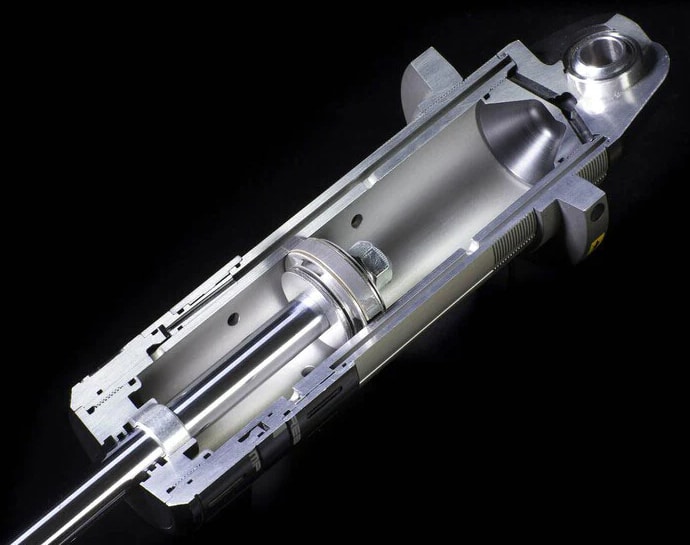
At the time of writing, internal bypass shocks are gaining popularity because they’re as effective as external bypass shocks, with the added advantage of a smaller form factor and lighter weight.
Instead of bypass tubes located on the outside of the shock body, these work by routing the bypass oil through tiny incisions and passages in the shock’s hollow shaft. The design vaguely resembles that of twin-tube shocks.
These passages are located in the same position (ride zone) as the tubes would be located in an external bypass shock.
This way, you get the best of both worlds — you get the flexibility of external bypass zones / shocks, along with the form factor of coilovers.
Best Shocks for Daily Driven Tacomas
Now that you have a slightly better understanding of what all to consider when purchasing off-road shocks, let’s check out some of the different suspension options for your Tacoma.
There are quite a few options below, but the right choice really comes down to what generation Tacoma you drive and how you drive it.
Bilstein 5100

Manufacturer: Bilstein
Type: Monotube damper
Compatible years: 2005-2015
Country of origin: Germany
Part number: 24-239370/24-186728
Buy on: Amazon
Bilstein’s B8 5100 shock set is a staple in the off-road community, especially among Tacoma owners. It’s the perfect happy-medium shock when it comes to maintaining drivability on-road and off-road.
Their 46 mm monotube design ensures fade-free performance in most conditions, and valving is digressive from the factory, which makes it perfect for road use and for stuff like cruising fire roads and light trails.
Additionally, these Bilstein shocks come with multiple snap ring grooves that allow you to change ride height anywhere from 0″ to 2.5″.
These don’t come with springs though, so you can either reuse your stock coils or pair them up with something from Eibach or Swift Springs.
Monroe Quick Strut

Manufacturer: Monroe
Type: Twin-tube coilover
Compatible years: 1998+ Tacoma
Country of origin: China
Part number: 171352R/171352L
Buy on: Amazon (Right) | Amazon (Left)
If you don’t need top-of-the-line struts because you’re not heading off-road and just want something that works, then consider these Monroe shocks and struts for your Tacoma.
Just make sure that if you order these shocks for your Tacoma that you order one for the right side of the vehicle (171352R) and one for the left side (171352L).
They’re not interchangeable, and the last thing you want is to get everything pulled apart only to realize you have the wrong part!
KYB Excel-G

Manufacturer: KYB
Type: Twin-tube damper (pair)
Compatible years: 1998+
Country of origin: Japan
Part number: 341340
Buy on: Amazon
If you need to replace your Tacomas shocks, why not go with Toyota’s first choice? The KYB Excel-G Gas Strut is the OEM replacement part for 2-wheel drive Tacomas, so you’ll get stock-level performance just like it was when it rolled off the production line.
It’s not an upgrade, but it’s certainly not a downgrade either. If you were happy with the performance you were getting from the shocks before they gave out, why not go back to the same part and get the same performance?
Rancho Suspension QuickLIFT

Manufacturer: Rancho Suspension
Type: Twin-tube rear dampers and front coilovers
Compatible years: 2005-2012
Country of origin: Australia
Part number: 999915/999319
Buy on: Amazon
The QuickLIFT series by Ranch Suspension offers 9-levels of damping adjustments along with a limited lifetime warranty. It includes 2 rear dampers and two coilovers for the front end.
Top-mounts are included with the coilovers. Overall, the kit is ideal for evening-out the factory nose-down rake as it offers a 2.5″ to 3″ lift.
It’s a bolt-on solution that’s ideal for light-duty off-roading right out of the box. The installation is very straightforward as well.
Fox 2.5 Factory Series
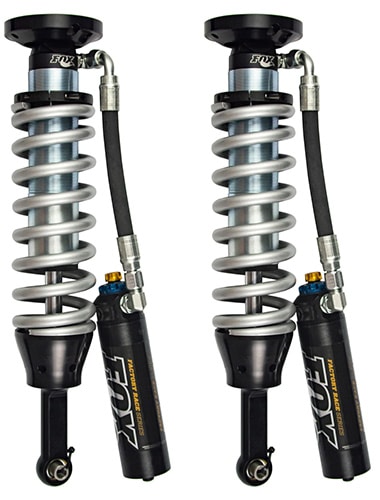
Manufacturer: Fox
Type: Remote reservoir coilovers
Compatible years: 05+
Country of origin: USA
Part number: 880-06-376
Buy on: Amazon
Fox’s Factory Series coilovers are ideal for competitive use as well as extreme overlanding. These come equipped with an external reservoir for maximum heat dissipation.
You get variable compression and rebound damping, along with adjustable preload. Max lift height is capped at 2″.
They utilize JM91 advanced suspension fluid for optimal performance at variable temperatures. Combine that with a T6-6061 hard anodized high-flow piston and it makes sense why Fox claims these coilovers to be race-ready.
Also, these are just the front coilovers, rear dampers and springs will have to be sourced separately.
Skyjacker Black MAX

Manufacturer: Skyjacker
Type: Foam-cell
Compatible years:
Country of origin: Mexico
Part number: B8527
Buy on: Amazon
If you’re on a tight budget, the Skyjacker Black MAX Shock Absorber might be exactly what you need to get yourself out of a pinch and get your truck back on the road.
We’re not going to tell you that they’re the best shock absorbers out there because they’re not, but they will get the job done for you for a while.
They’re the best you’re going to get at this price range, and you’re not putting sketchy parts on your truck.
DTA 70090X
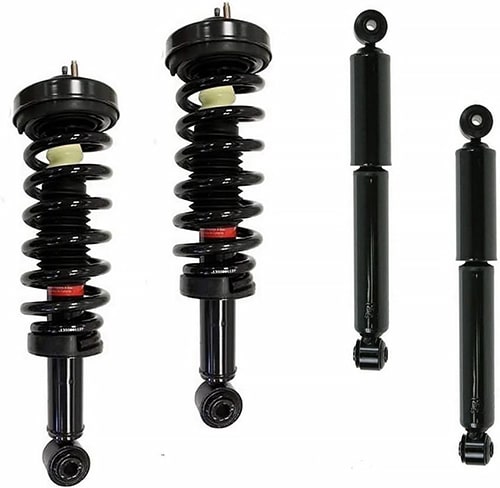
Manufacturer: Drive Tech America
Type: Rear dampers, front coilovers
Compatible years: 1995+
Country of origin: USA
Part number: 70090X
Buy on: Amazon
If you drive a first-generation Tacoma, and you’re looking for an OEM+ shock replacement kit, then this set of Drive Tech America struts is a good choice.
It comes with everything you need to replace the entire strut assembly on both the front and rear axles, and it comes at a great price.
While we wouldn’t recommend this assembly for extreme off-roading, it’s great for a comfortable and level ride on the road.
And considering you’re getting the full assembly for both the front and rear axle, this kit is available at an excellent price!
Torch Off-Road Extended
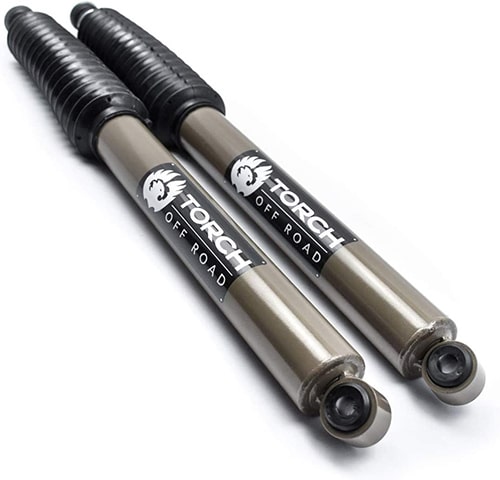
Manufacturer: Torch Off-Road
Type: Rear monotube dampers
Compatible years: 2005+
Country of origin: China
Part number: 689355919108
Buy on: Amazon
If you already have a 2″ to 4″ lift on your Tacoma and need to upgrade your shocks, one of the more affordable ways to go about things is with this set of Torch Off-Road shocks.
They work perfectly for lifted trucks, but they’re not exactly known for giving you the smoothest ride.
Still, they’re durable enough to handle off-road driving, and they fit perfectly on a lifted Tacoma. They come with a 5-year, 50,000-mile warranty too, which is great considering they’re off-road shocks.
Rough Country N3

Manufacturer: Rough Country
Type: Monotube dampers
Compatible years: 05+
Country of origin: USA
Part number: 23213_A
Buy on: Amazon
If you’re specifically looking for affordable, American-made shocks for your lifted Tacoma, then these are a great option.
While the Rough Country N3 Rear Shocks aren’t as compliant as the Torch Off-Road shocks, they are a reliable set you can use on your lifted truck.
They also have a wider working range, as they are a great choice for trucks with a 2.5″ to 5.5″ lift. They’re better suited for on-road applications, but they are durable enough to handle some off-roading.
Our Top Picks
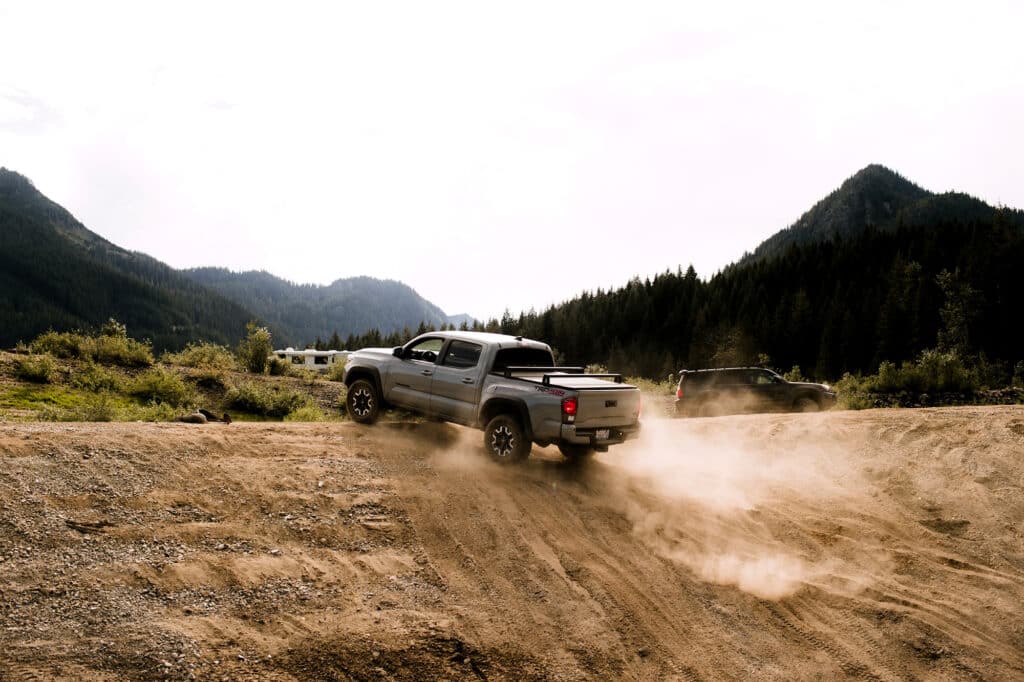
Best shocks for 4wd Tacomas: Fox 2.5 Factory Series
4wd Tacoma owners who are just getting started with serious off-roading should definitely consider the 2.5 Factory Series coilovers by Fox.
They’re the most expensive option on this list, but it’s worth noting that these aren’t as advanced as some of the other beastly external/internal bypass shocks that you can buy for 3 times the price of these.
2.5 Factory Series coilovers are an excellent gateway into the world of technical off-road.
Best shocks for 2wd Tacomas: Bilstein 5100
If you’re looking for the best Tacoma shocks to get you off the beaten path every once in a while, then the Bilstein 5100s are definitely worth considering.
They’re so well-trusted that Toyota themselves use them for their upgraded suspension systems, and they’re exactly what you want if that’s what you’re doing yourself.
The Bilstein monotube gas shock set is a rare find — a set of shocks that give you outstanding and reliable off-road performance, all while giving you a smooth ride when you are on the road.
The only real trade-off with these shocks is that they’re a bit more expensive, but when you factor in what you’re getting, we think they’re well worth every penny.
Best OEM replacement: KYB Excel-G
If all you’re planning on doing is driving around on the road in your Tacoma, there’s no reason to get the bulkiest shocks on the market. You want something that’s going to give you a smooth ride.
In that case you absolutely want to go with the OEM replacement shocks. This restores the performance of the shocks right back to where they were when the truck was brand new.
Another advantage of going with these OEM replacement shocks is that they don’t cost a fortune, so you don’t need to worry about breaking the bank to get these shocks in hand.
Which one of these shocks caught your attention the most? Are there any more that you wish to see on this list? Let us know by leaving a comment below!

